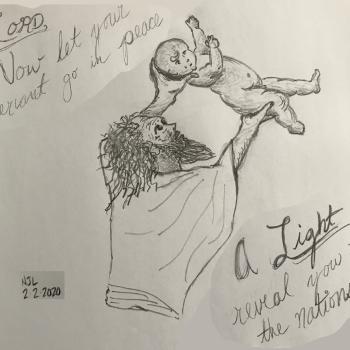A photo has been zipping around my neighborhood of Facebook the last day or two, although the photo itself is a few months old. It shows Licia Ronzulli, a member of the EU parliament, casting a vote with her infant daughter nestled on her chest in a fabric sling. As anybody who has ever carried an infant in a sling in public can attest, there is something powerfully attractive about the intimacy of a mother (or father!) cradling an infant close, and that attraction combined with the political implication of the photo make it a potent image any time of the year.
At this time of the year, though, more than any other, it's powerful. With Christmas upon us, images of Mary and the baby Jesus, the iconic mother-child dyad, greet the eye at every turn, especially in the nativity scenes that inhabit our mantles in December. My children love to arrange and rearrange the figurines in our set, always keeping Mary and her infant at the center of the scene. But Mary, unlike Licia, is not holding her baby close: almost invariably in these nativity representations, the infant Jesus lies alone on his back, arms outstretched, in the manger of hay. And no wonder, since the gospels describe the scene quite clearly: Mary wrapped the child in swaddling clothes, and laid him in a manger, because there was no room for them in the inn.
It wasn't until I had children that I realized the absurdity of this traditional representation: my babies, like many if not most infants, hate to be put down on their backs. Alone on their backs, they startle violently at any stimulus and seem profoundly insecure. They hate to be put down at all, in fact. Verticality, skin-to-skin contact, and constant motion are the conditions of infant nirvana. Mine would no sooner tolerate being left alone on their backs in a manger than they would break into a rendition of "Oh Holy Night."
Then a few years ago I read Sarah Blaffer Hrdy's book Mothers and Others, a study of the evolutionary implications of human parenting practices, and it struck me that it isn't only baby Jesus who behaves unnaturally in the traditional nativity scene—it's Mary herself. What kind of mother, having just delivered an infant in an unfamiliar, unclean, and insecure environment, would then put the child down to lie apart from her, utterly vulnerable and exposed? Why not hold the baby in her arms where he is warm, secure, and comfortable, or at least ask Joseph to hold him? Mary was a first-time mother, and inexperienced mammal mothers sometimes fail to nurture their infant offspring adequately—but even so, what are we to make of this most revered of all human mothers who seems to fail at the first and most basic task of infant care?
Evolutionary biology is not generally brought to bear on the Christian nativity, it's true, but consider for a moment Mary's behavior in the larger context of primate mothers. The attachment between baby primates and their mothers is the first, most powerful, and longest lasting of any relationship. Under natural conditions, infant chimps, orangutans, or gorillas are inseparable from their mothers, remaining in intimate front-to-front contact 100 percent of the day and night. A great ape mother is fiercely possessive of her infant, and it is months before she will allow any other individual, even her own older offspring, to hold the baby. Under this model of constant maternal care and contact, Mary's behavior is unthinkable: no mother who intends to nurture her infant would leave him alone, out of contact and insecure.
It's not quite fair to hold Mary to the standard of those single-mindedly devoted non-human great ape mothers, though. Because human mothers are different: starting from the moment of delivery, an unusually dangerous experience for the human mother which she cannot accomplish without help of some kind, she must allow other caregivers to hold her infant. Human mothers, even in hunter gatherer societies, routinely allow trusted substitutes to hold, comfort, and nourish their infants some of the time. (Outside of the industrialized West, however, it's highly uncommon for babies to sleep at night apart from their mothers—and virtually unheard of for them to sleep alone, as Western infants routinely do.) In a human context, then, Mary's leaving her tiny baby lying alone in a manger is unusual but probably not unnatural. Chances are even Licia Ronzulli employs a substitute caregiver some of the time.
What can it mean, both that human mothers approach a continuous-care-and-contact model of mothering and that they sometimes let their infants out of their grasp? John Bowlby, an important evolutionary thinker and the pioneer of attachment theory, answered the first question: a human child develops a secure sense of self only in the context of a trusting relationship with her mother, or a permanent mother substitute. And Sarah Blaffer Hrdy, building on Bowlby's work, proposes an answer to the second question: a human child develops an empathetic sense of other only in the context of positive extra-maternal interactions. Human children, with their unique capacities for both self-directed-consciousness and other-directed-empathy, need mothers to hold them, yes, and also to put them down. They need mothers and others.





